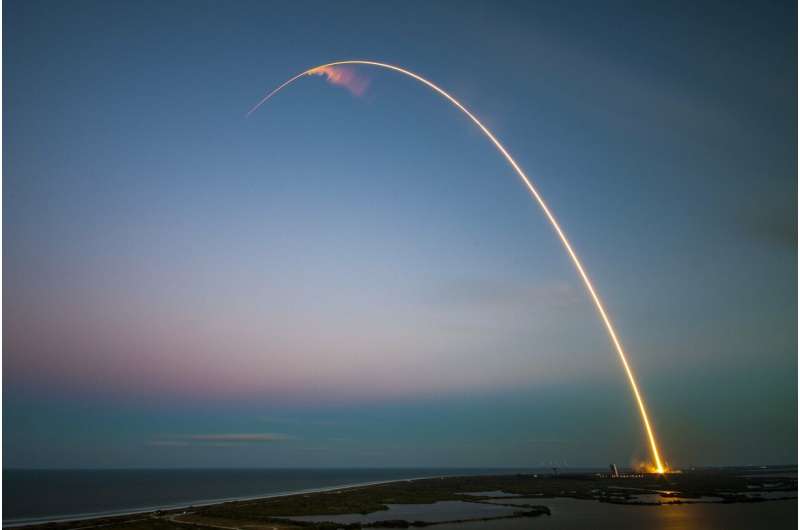
Copernical Team
Weather clears as SpaceX knocks out overnight satellite launch

After a week of stormy weather delays, SpaceX waited just a bit longer but managed an early Saturday liftoff of a satellite to knock out the Space Coast's 26th launch of the year.
A Falcon 9 carrying the Arabsat BADR-8 telecommunications satellite headed for geosynchronous orbit let the winds die down from the opening of the launch window late Friday, but managed to blast off from Cape Canaveral Space Force Station's Space Launch Complex 40 at 12:30 a.m. a little over an hour later.
It was the fourth night launch for SpaceX this month with three previous successful Starlink missions from Cape Canaveral lighting up the sky in the wee hours.
The first-stage booster made its 14th flight with a recovery on SpaceX's droneship Just Read the Instructions down range in the Atlantic Ocean. It was the 195th time the company has recovered a booster from its rockets.
This was the second launch SpaceX has done for Arabsat following what was the first Falcon Heavy launch with a customer in 2019. SpaceX has a third launch contracted for what will be the first of Arabsat's seventh-generation satellites.
China plans to land astronauts on moon before 2030, another step in what looks like a new space race

China prepares to send first civilian into space
 China will send its first civilian astronaut into space as part of a crewed mission to the Tiangong space station on Tuesday as it pursues its ambitious plans for a manned lunar landing by 2030.
The world's second-largest economy has invested billions of dollars in its military-run space programme, trying to catch up with the United States and Russia after years of belatedly matching their m
China will send its first civilian astronaut into space as part of a crewed mission to the Tiangong space station on Tuesday as it pursues its ambitious plans for a manned lunar landing by 2030.
The world's second-largest economy has invested billions of dollars in its military-run space programme, trying to catch up with the United States and Russia after years of belatedly matching their m China to send first civilian to space on Tuesday: space agency
 China will send its first civilian astronaut into space as part of a crewed mission to the Tiangong space station on Tuesday, the country's Manned Space Agency said.
"Payload expert Gui Haichao is a professor at Beijing University of Aeronautics and Astronautics," China Manned Space Agency Spokesperson Lin Xiqiang told reporters Monday.
Until now, all Chinese astronauts sent into space h
China will send its first civilian astronaut into space as part of a crewed mission to the Tiangong space station on Tuesday, the country's Manned Space Agency said.
"Payload expert Gui Haichao is a professor at Beijing University of Aeronautics and Astronautics," China Manned Space Agency Spokesperson Lin Xiqiang told reporters Monday.
Until now, all Chinese astronauts sent into space h China to launch Shenzhou 16 on Tuesday
 The Shenzhou XVI spacecraft, transporting three Chinese astronauts to the Tiangong space station, is slated to launch on Tuesday morning, the China Manned Space Agency has announced.
Marking the inaugural mission for China's third generation of astronauts, this event will also represent the first occasion a Chinese civilian ventures beyond Earth's atmosphere.
Speaking at a news confe
The Shenzhou XVI spacecraft, transporting three Chinese astronauts to the Tiangong space station, is slated to launch on Tuesday morning, the China Manned Space Agency has announced.
Marking the inaugural mission for China's third generation of astronauts, this event will also represent the first occasion a Chinese civilian ventures beyond Earth's atmosphere.
Speaking at a news confe Planet Partners with UAE to build satellite atlas for climate resilience
 Planet Labs PBC (NYSE: PL) has announced a partnership with the United Arab Emirates (UAE) Space Agency, to build a regional satellite data-driven loss and damage atlas for climate change resilience. The initiative aims to provide data to a select country facing high degrees of climate risk to help build resilience, make informed policy decisions, and stimulate financial programs for climate ada
Planet Labs PBC (NYSE: PL) has announced a partnership with the United Arab Emirates (UAE) Space Agency, to build a regional satellite data-driven loss and damage atlas for climate change resilience. The initiative aims to provide data to a select country facing high degrees of climate risk to help build resilience, make informed policy decisions, and stimulate financial programs for climate ada NASA Successfully Completes Globetrotting SuperBIT Balloon Flight
 NASA successfully completed a flight test of its super pressure balloon carrying the Super Pressure Balloon Imaging Telescope (SuperBIT) science mission at 9:27 a.m. EDT, Thursday, May 25, after some 39 days and 14 hours of flight.
The mission began at 11:42 a.m., Sunday, April 16 (7:42 p.m. April 15 in U.S. Eastern Time) launching from Wanaka Airport, New Zealand, which is NASA's long-dur
NASA successfully completed a flight test of its super pressure balloon carrying the Super Pressure Balloon Imaging Telescope (SuperBIT) science mission at 9:27 a.m. EDT, Thursday, May 25, after some 39 days and 14 hours of flight.
The mission began at 11:42 a.m., Sunday, April 16 (7:42 p.m. April 15 in U.S. Eastern Time) launching from Wanaka Airport, New Zealand, which is NASA's long-dur NASA-developed spherical robots to the rescue
 Dr. Alice Agogino was researching spherical, skeletal robots that might one day be dropped onto Mars or the Moon to collect information and conduct science, when she realized her NASA-funded technology could have terrestrial benefits too.
Reading a report on the dangers and death toll of disaster response, Agogino thought her robots, fitted with the right sensors, could gather data at the
Dr. Alice Agogino was researching spherical, skeletal robots that might one day be dropped onto Mars or the Moon to collect information and conduct science, when she realized her NASA-funded technology could have terrestrial benefits too.
Reading a report on the dangers and death toll of disaster response, Agogino thought her robots, fitted with the right sensors, could gather data at the China's hypersonic missiles threaten US power in the Pacific
 China's newest hypersonic missile, the DF-27, can fly as far as Hawaii, penetrate U.S. missile defenses and pose a particular threat to U.S. aircraft carriers, according to news reports of an assessment from the Pentagon.
Chinese researchers claimed in a May 2023 research journal report that the country's hypersonic missiles could destroy a U.S. carrier group "with certainty." This capabil
China's newest hypersonic missile, the DF-27, can fly as far as Hawaii, penetrate U.S. missile defenses and pose a particular threat to U.S. aircraft carriers, according to news reports of an assessment from the Pentagon.
Chinese researchers claimed in a May 2023 research journal report that the country's hypersonic missiles could destroy a U.S. carrier group "with certainty." This capabil NASA's HyTEC Engine Core Project Show Progress
 NASA has made significant progress toward its goal of creating a more fuel-efficient jet engine core for next-generation sustainable commercial aircraft. In just a year and a half since it began, the Hybrid Thermally Efficient Core (HyTEC) project already is moving forward into the advanced testing required before conducting an engine core demonstration with industry partners.
"The first s
NASA has made significant progress toward its goal of creating a more fuel-efficient jet engine core for next-generation sustainable commercial aircraft. In just a year and a half since it began, the Hybrid Thermally Efficient Core (HyTEC) project already is moving forward into the advanced testing required before conducting an engine core demonstration with industry partners.
"The first s 